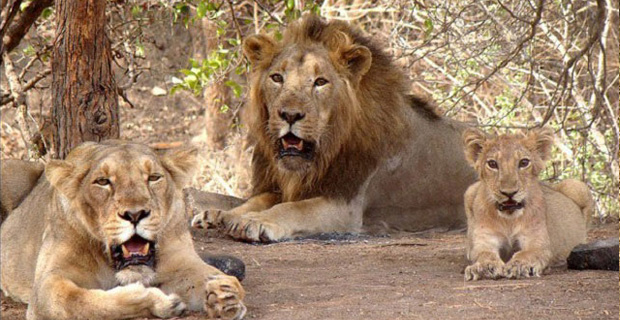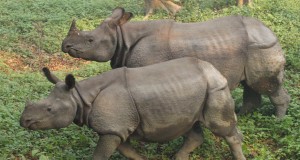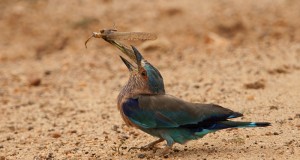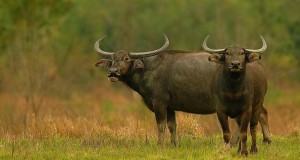The lion has always occupied a unique position in India. More than 2000 years ago Emperor Ashoka chose to inscribe some of his edicts on the famous lion capital of Sarnath which is today the emblem of the Republic of India. This magnificent animal once roamed all over North India up to Bihar, but in the last one hundred years it has been wiped out elsewhere and today, the only surviving population of lions outside the continent of Africa is found in the Gir forest. Always considered royal game by rulers in India from time immemorial, lions were protected. But modernization and the disappearance of their habitat have left them with only the Gir, their last habitat and their last refuge. 
Home of the Asiatic Lion: In the southwest of the Saurashtra peninsula of Gujarat state, an area of 545 sq miles (1412 sq km) of forest and grassland survives amid increasing pressure of human and cattle population. The forest area itself has shrunk by half since the turn of the century and what remains is the Gir Sanctuary with a core area of 116 sq miles (300 sq km) which has been declared 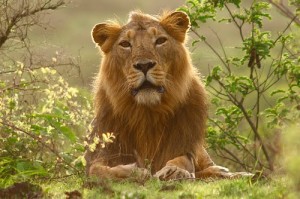 a National Park. It is no longer connected to even the Girnar mountain where, until recently, lions were often reported on the outskirts of Junagadh city. Sasan, with a forest rest house, is the headquarters of the sanctuary.
a National Park. It is no longer connected to even the Girnar mountain where, until recently, lions were often reported on the outskirts of Junagadh city. Sasan, with a forest rest house, is the headquarters of the sanctuary.
The Gir is a mixed deciduous type of forest with teak, her, flame of the forest, jamun, a variety of acacia particularly babul and an occasional banyan tree. It is a hilly tract with many rivers and offers to the visitor long pleasant drives of quiet beauty. At the turn of the 19th – 20th Century there was a disastrous famine which lives in local memory as the “chappanio kal.” The lion’s prey population fell drastically and li ons took to man-eating and their numbers declined drastically. It is believed that they were on the verge of extinction in 1913, with only about 20 animals left.
However, the Nawab of Junagadh, in whose domain most of the Gir forest fell, protected them vigorously and since independence in 1947 protection has continued, and lion hunting has been totally banned since the mid -1950s. As the Gir was the only home of the Asiatic lion, there was an urgent need to establish their status. Consequently, the first systematic census of large mammals in India was conducted in the Gir in 1950 by the late M.A. Wynter-Blyth and the late R.S. Dharmakumarsinhji, both naturalists of outstanding ability. This set the trend for such censuses elsewhere in India, particularly those of tigers. According to the 1985 census, there are 239 lions in the Gir forest as against 205 in 1979.
both naturalists of outstanding ability. This set the trend for such censuses elsewhere in India, particularly those of tigers. According to the 1985 census, there are 239 lions in the Gir forest as against 205 in 1979.
The best way to observe lions is, of course, in their natural surroundings at dawn and dusk, when these predators are on the move. This can be done from a car as, owing to the protection given to them, they are not shy of motor vehicles. Nevertheless, one cannot be certain about seeing them on all occasions. The Forest Department arranges lion shows every 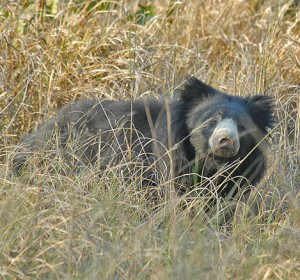 Sunday which become a mela of scores of people watching lions attracted by a buffalo. It is proposed that the Forest Department should discontinue the lion shows and instead set up a `safari park” in a fenced-off area of about 1000 acres (400 hectares) of the forest where seeing lions would be more certain.
Sunday which become a mela of scores of people watching lions attracted by a buffalo. It is proposed that the Forest Department should discontinue the lion shows and instead set up a `safari park” in a fenced-off area of about 1000 acres (400 hectares) of the forest where seeing lions would be more certain.
The Asiatic lion is slightly smaller than its African cousin and its mane is smaller too. Nonetheless, a large male lion of the Gir is indeed a sight to behold. A former Nawab, Sir Mahabat Khanji of ofiunagadh, ordered a series of Gir lion postage stamps for his state way back in 1929, thus making the Asiatic li on the first wild animal to figure philatelically in India.
There have been two attempts in the past at translocatirig lions both of which failed in the long run. The Gujarat State Government now proposes to establish a second home for lions in the Barda hills near Porbandar. It is proposed to set aside a 70-sq-mile (180-sq-km) area for the purpose. The success of this enterprise will depend on the availability of prey animals and sufficient area for the lion population to take root undisturbed. It was the obvious lack of these conditions which saw the end of the lions in this area some 80 years ago. Today the Barda hills area is no longer connected to the Gir as was the case then. The Gir, therefore, remains the sole haven of the Asiatic lion, which, above all, is its unique attraction. 
The Hunters and the Hunted: The Gir has always also had a large population of panthers and they are more visible here than in other Indian forests. At the last count in 1985 there were 201 panthers as against 161 in 1979. If one is lucky, they can be encountered while driving through the forest.
According to the 1985 census, sambar number 772, chital 10,446, nilgai 2081 , fourhorned antelope 1063, chutkara (Indian gazelle) 311, wild boar 2212 and langur 6912. These are the prey population for the big cats, along with domestic cattle. Over the earlier census of 1979, chital, the most prolific breeders of the lot, have increased by only 2000 with a base population of approximately 8000. The numbers of sambar, four-horned antelope and langur have been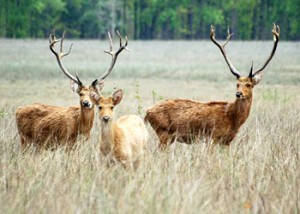 virtually stable, whereas nilgai, wild boar and chinkara have actually registered a marginal decline.
virtually stable, whereas nilgai, wild boar and chinkara have actually registered a marginal decline.
Among the other carnivores are the wild cat, the jackal and the hyena, the population of which has increased to 192 in 1985 from 84 in 1979. The census is perhaps reasonably accurate as far as lions are concerned because of their noisy and gregarious habits but, for some of the other species, the accuracy of the figures is debatable.
The sloth bear is conspicuous by its absence from the Gir. Pythons and many species of snakes have been recorded. The Gir is an excellent area for seeing marsh crocodiles in its rivers but particularly in the lake of Kamaleshwar dam. There is a crocodile breeding farm at Sasan. It is from this farm that these reptiles are taken to restock the lakes and rivers of Gujarat.
The forest is remarkably rich in birdlife too. Paradise flycatcher, black-headed cuckoo shrike,  gray drongo, pied woodpecker, coppersmith, Indian roller, crested swift, fish owl, black vulture, shaheen falcon. BoneIli’s eagle, crested serpent eagle, painted sandgrouse. rock bush quail, gray partridge, white-necked stork, are among the many species of birds found here. Wildlife viewing in the Gir is best done by driving around the forest. The best drives from Sasan are to Baval Chowk and Kankai, to Chodavdi and Tulsishyam, and to Kamaleshwar dam. The roads are manageable by a sturdy car, but a jeep is definitely advisable. The best time for viewing is at sunrise and sunset as the animals are most active at these times.
gray drongo, pied woodpecker, coppersmith, Indian roller, crested swift, fish owl, black vulture, shaheen falcon. BoneIli’s eagle, crested serpent eagle, painted sandgrouse. rock bush quail, gray partridge, white-necked stork, are among the many species of birds found here. Wildlife viewing in the Gir is best done by driving around the forest. The best drives from Sasan are to Baval Chowk and Kankai, to Chodavdi and Tulsishyam, and to Kamaleshwar dam. The roads are manageable by a sturdy car, but a jeep is definitely advisable. The best time for viewing is at sunrise and sunset as the animals are most active at these times.
Lions and Man: The Gir is steeped in history and folklore. It has temples of great antiquity like Kankai Mata and Tulsishyam, a place of pilgrimage with hot springs. The forest is famous for its cattle herders, the Maldharis, whose buffaloes form a substantial part of the lions’ food. These herdsmen live in small thorn-fenced settlements called nes, which are well worth visiting. Extremely hospitable 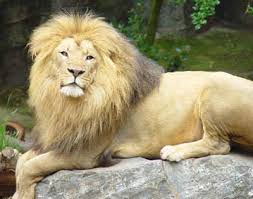 by nature, the Maldharis arc herders whose life has changed but little over the years and their folklore and traditions are a unique record of coexistence of human beings with lions. A major problem of the sanctuary continues to be the human population and their cattle herds, despite certain steps being taken to meet this situation. For example, a rubble wall around the sanctuary prevents some herdsmen and their cattle from entering the sanctuary, but sizable human and cattle populations remain within it. The cattle population within the sanctuary is estimated at 20,000, and these compete for food and territory with the wild ungulates. Because of such disturbances, one does not in the Gir see sambar, chital, nilgai, etc. in such numbers and concentrations as one does in better protected sanctuaries and national parks. Actually, cattle form a very substantial part of a lion’s diet today, and, in seeming paradox, unless the Maldharis and their cattle are progressively removed, the Gir’s natural prey population cannot increase; in fact it will continue to remain under constant threat of epidemics and a sudden drastic reduction in numbers. The sanctuary usually remains closed from June to October and the best time to visit the forest is between December and March. The summer temperature can be as high as 104° F (40°C) while in winter it can be as low as 43° F (6° C).
by nature, the Maldharis arc herders whose life has changed but little over the years and their folklore and traditions are a unique record of coexistence of human beings with lions. A major problem of the sanctuary continues to be the human population and their cattle herds, despite certain steps being taken to meet this situation. For example, a rubble wall around the sanctuary prevents some herdsmen and their cattle from entering the sanctuary, but sizable human and cattle populations remain within it. The cattle population within the sanctuary is estimated at 20,000, and these compete for food and territory with the wild ungulates. Because of such disturbances, one does not in the Gir see sambar, chital, nilgai, etc. in such numbers and concentrations as one does in better protected sanctuaries and national parks. Actually, cattle form a very substantial part of a lion’s diet today, and, in seeming paradox, unless the Maldharis and their cattle are progressively removed, the Gir’s natural prey population cannot increase; in fact it will continue to remain under constant threat of epidemics and a sudden drastic reduction in numbers. The sanctuary usually remains closed from June to October and the best time to visit the forest is between December and March. The summer temperature can be as high as 104° F (40°C) while in winter it can be as low as 43° F (6° C).

